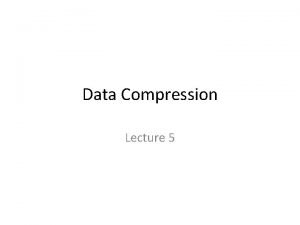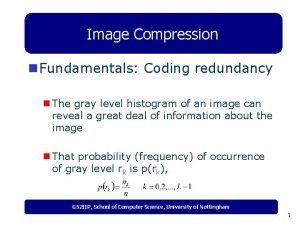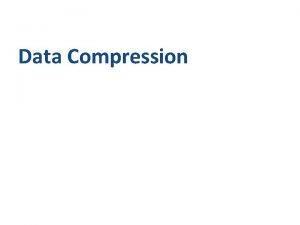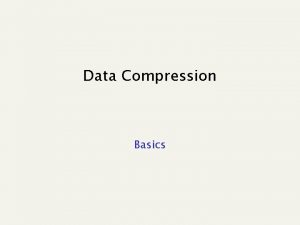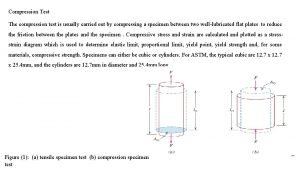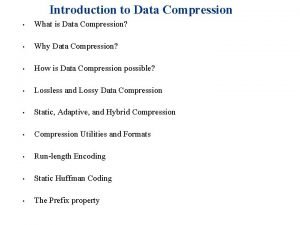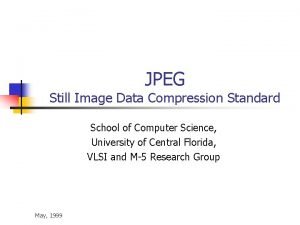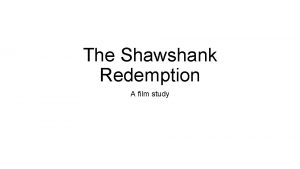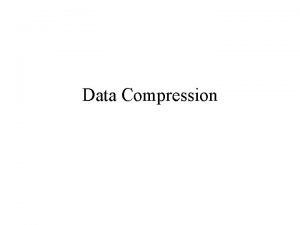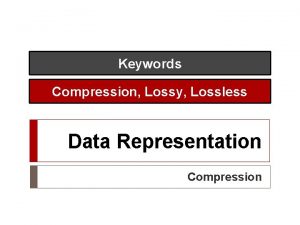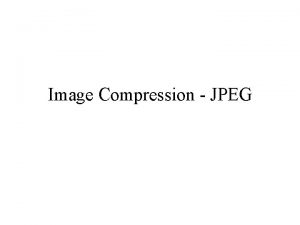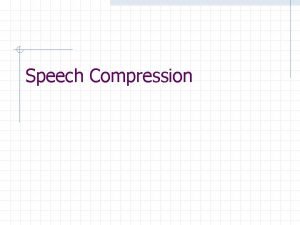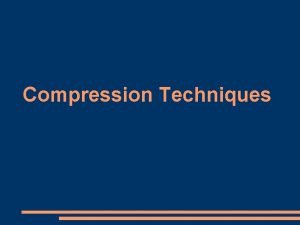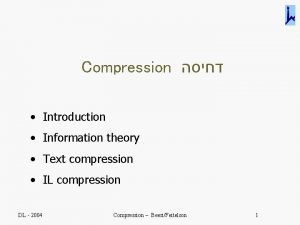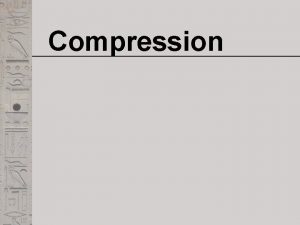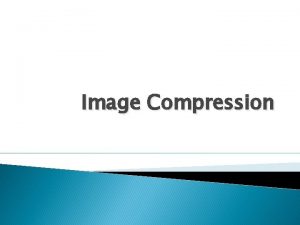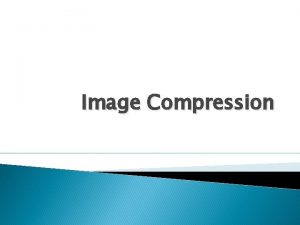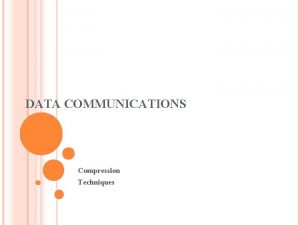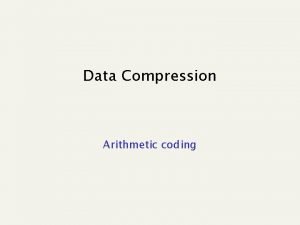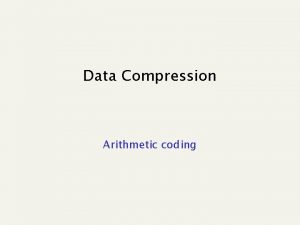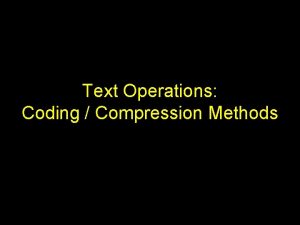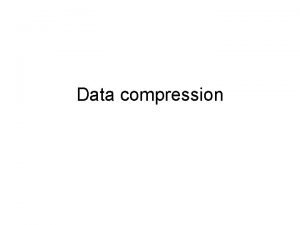Data Compression Lecture 3 Coding Recap Coding rate








![Encoding Example Symbol, x Probability, N[x] [Q[x-1], Q[x]) A 0. 4 0. 0, 0. Encoding Example Symbol, x Probability, N[x] [Q[x-1], Q[x]) A 0. 4 0. 0, 0.](https://slidetodoc.com/presentation_image_h/8cde2177dfdcb4950dc8a0b43049b321/image-9.jpg)










- Slides: 19

Data Compression Lecture 3

Coding Recap • Coding rate is the average number of bits used to represent a symbol from a source. • For a given probability model, the entropy is the lowest rate at which the source can be coded. • It has been shown that Huffman coding will generate whose rate is within p_max + 0. 086 • Therefore, in Huffman coding, when the alphabet size is large, the amount of deviation from the entropy is quite small, and vice versa

Coding Recap • One solution for this problem is blocking in Huffman coding. In which, it is more efficient to generate codewords for groups or sequences of symbols rather than to generate a separate codeword for each symbol in a sequence. • In order to find the Huffman coding for a sequence of length m, we need codewords for all possible sequences of length m. • This causes an exponential growth in the size of the code book.

Arithmetic coding • We need a way of assigning codewords to particular sequences with out having to generate a codes for all sequences of that length. • Rather than separating the input into component symbols and replacing each with a code, arithmetic encodes the entire message with a number (tag). • Firstly, a unique identifier or tag is generated for a sequence. Secondly, this tag is then given a unique binary code.

Arithmetic coding • Entropy encoding • Lossless data compression • Variable length coding

Arithmetic coding is based on the concept of interval subdividing. – In arithmetic coding a source ensemble is represented by an interval between 0 and 1 on the real number line. – Each symbol of the ensemble narrows this interval. – As the interval becomes smaller, the number of bits needed to specify it grows. – Arithmetic coding assumes an explicit probabilistic model of the source. – It uses the probabilities of the source messages to successively narrow the interval used to represent the ensemble. • A high probability message narrows the interval less than a low probability message, so that high probability messages contribute fewer bits to the coded ensemble

Arithmetic coding • Assume we know the probabilities of each symbol of the data source, – we can allocate to each symbol an interval with width proportional to its probability, and each of the intervals does not overlap with others. – This can be done if we use the cumulative probabilities as the two ends of each interval. Therefore, the two ends of each symbol x amount to Q[x-1] and Q[x]. – Symbol x is said to own the range [Q[x-1], Q[x]).

Arithmetic Encoding We begin with the interval [0, 1) and subdivide the interval iteratively. • For each symbol entered, the current interval is divided according to the probabilities of the alphabet. • The interval corresponding to the symbol is picked as the interval to be further proceeded with. • The procedure continues until all symbols in the message have been processed. • Since each symbol's interval does not overlap with others, for each possible message there is a unique interval assigned. • We can represent the message with the interval's two ends [L, H). In fact, taking any single value in the interval as the encoded code is enough, and usually the left end L is selected.
![Encoding Example Symbol x Probability Nx Qx1 Qx A 0 4 0 0 0 Encoding Example Symbol, x Probability, N[x] [Q[x-1], Q[x]) A 0. 4 0. 0, 0.](https://slidetodoc.com/presentation_image_h/8cde2177dfdcb4950dc8a0b43049b321/image-9.jpg)
Encoding Example Symbol, x Probability, N[x] [Q[x-1], Q[x]) A 0. 4 0. 0, 0. 4 B 0. 3 0. 4, 0. 7 C 0. 2 0. 7, 0. 9 D 0. 1 0. 9, 1. 0

Encoding Algorithm L = 0. 0; H = 1. 0; While ( (x = getc(input)) != EOF ) { R = (H-L); H = L + R * Q[x]; L = L + R * Q[x-1]; } Output(L); R is the interval range, and H and L are two ends of the current code interval. x is the new symbol to be encoded. H and L are initialized to 0 and 1 respectively

Utilized equations

To encode the sequence 1 3 2 1

Arithmetic Decoding • Lets decode the tag value 0. 772352 • Given

Arithmetic Decoding • The possible value for is 2

Arithmetic Decoding

Decoding Algorithm q When decoding the code v is placed on the current code interval to find the symbol x so that Q[x-1] <= code < Q[x]. The procedure iterates until all symbols are decoded. v = input_code(); for (; ; ) { x = find_symbol_straddling_this_range(v); putc(x); R = Q[x] – Q[x-1]; v = (v – Q[x-1])/R; }

Generating a binary code

Binary code example

Binary code • Is uniquely decodable as it satisfies the prefix property
 Contoh open coding
Contoh open coding Contoh open coding, axial coding selective coding
Contoh open coding, axial coding selective coding Adaptive huffman code
Adaptive huffman code Coding redundancy
Coding redundancy Data compression in data mining
Data compression in data mining Cpr compression rate
Cpr compression rate 01:640:244 lecture notes - lecture 15: plat, idah, farad
01:640:244 lecture notes - lecture 15: plat, idah, farad History of qualitative research
History of qualitative research Coding dna and non coding dna
Coding dna and non coding dna What is lossy data compression
What is lossy data compression Image compression
Image compression Which are uniquely decodable codes
Which are uniquely decodable codes Principles of data compression
Principles of data compression Compression test is carried on which material
Compression test is carried on which material Introduction to data compression
Introduction to data compression Lossless compression in multimedia
Lossless compression in multimedia Jpeg still image data compression standard
Jpeg still image data compression standard Jpeg still image data compression standard
Jpeg still image data compression standard Summary of shawshank redemption
Summary of shawshank redemption Great gatsby chapters 8-9 summary
Great gatsby chapters 8-9 summary


